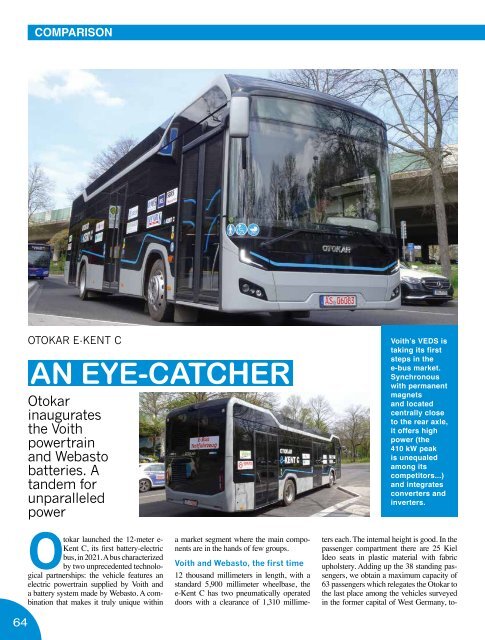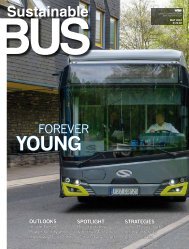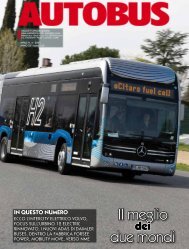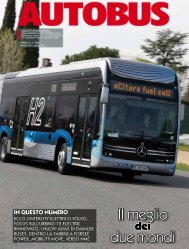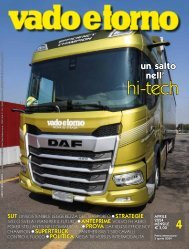2023-09 SUSTAINABLE BUS
A new issue of Sustainable Bus is out today. In this upcoming edition, we’ve curated a diverse and comprehensive range of topics that spotlight the latest developments in the world of sustainable mobility. From cutting-edge technological advancements to market insights and industry transformations, this issue promises to be a captivating exploration of the future of public transportation. What you could fine inside? Well, a market insight will offer you a detailed look at the European e-bus market, providing you with a comprehensive understanding of the mid-2023 results. The leading e-bus market in Europe is still UK: therefore, we focused our attention on that specific market with a report that sums up strategies, focus, goals of the most prominent industry players. A technology spotlight on the delicate topic of batteries, authored by Claudius Jehle, look at battery management and strategies to ensure the smooth and cost-effective operation of electric buses (with a focus on a case study from BVG). Among the pillars of our upcoming issue you’ll find a detailed journey around the European industrial bus&coach landscape. Goal? Providing our readers insights into the changing dynamics among key OEMs in the region. We’ll be then taking you behind the scenes at the Yutong factory in Zhengzhou, that we had the pleasure of visiting in June. Let’s then delve into Iveco Bus’s growing efforts in the zero-emission bus field. Finally, last but not least, a nearly-20-pages comparison between seven 12-meter battery-electric buses, gathered together in Bonn also this year by the German magazine Omnibusspiegel. You’ll find both established players and newcomers side by side: Ebusco 3.0, Hess lighTram 12m, Ikarus 120e, Iveco E-Way, Mercedes eCitaro with new batteries, Otokar e-Kent C, Quantron Cizaris 12 Ev.
A new issue of Sustainable Bus is out today. In this upcoming edition, we’ve curated a diverse and comprehensive range of topics that spotlight the latest developments in the world of sustainable mobility. From cutting-edge technological advancements to market insights and industry transformations, this issue promises to be a captivating exploration of the future of public transportation.
What you could fine inside? Well, a market insight will offer you a detailed look at the European e-bus market, providing you with a comprehensive understanding of the mid-2023 results. The leading e-bus market in Europe is still UK: therefore, we focused our attention on that specific market with a report that sums up strategies, focus, goals of the most prominent industry players.
A technology spotlight on the delicate topic of batteries, authored by Claudius Jehle, look at battery management and strategies to ensure the smooth and cost-effective operation of electric buses (with a focus on a case study from BVG).
Among the pillars of our upcoming issue you’ll find a detailed journey around the European industrial bus&coach landscape. Goal? Providing our readers insights into the changing dynamics among key OEMs in the region.
We’ll be then taking you behind the scenes at the Yutong factory in Zhengzhou, that we had the pleasure of visiting in June. Let’s then delve into Iveco Bus’s growing efforts in the zero-emission bus field.
Finally, last but not least, a nearly-20-pages comparison between seven 12-meter battery-electric buses, gathered together in Bonn also this year by the German magazine Omnibusspiegel. You’ll find both established players and newcomers side by side: Ebusco 3.0, Hess lighTram 12m, Ikarus 120e, Iveco E-Way, Mercedes eCitaro with new batteries, Otokar e-Kent C, Quantron Cizaris 12 Ev.
Create successful ePaper yourself
Turn your PDF publications into a flip-book with our unique Google optimized e-Paper software.
COMPARISON<br />
OTOKAR E-KENT C<br />
AN EYE-CATCHER<br />
Otokar<br />
inaugurates<br />
the Voith<br />
powertrain<br />
and Webasto<br />
batteries. A<br />
tandem for<br />
unparalleled<br />
power<br />
Voith’s VEDS is<br />
taking its first<br />
steps in the<br />
e-bus market.<br />
Synchronous<br />
with permanent<br />
magnets<br />
and located<br />
centrally close<br />
to the rear axle,<br />
it offers high<br />
power (the<br />
410 kW peak<br />
is unequaled<br />
among its<br />
competitors...)<br />
and integrates<br />
converters and<br />
inverters.<br />
gether with the E-Way. It is not only the tare<br />
exceeding 14 tons that has an influence, but<br />
also the GVW set up at 18 tons.<br />
Ten battery modules, supplied by the German<br />
Webasto as anticipated, are divided<br />
between the roof and the left part of the rear,<br />
where the inverter is also located (the impact<br />
on the five-seater livability is relevant).<br />
In the name of modularity, the minimum is<br />
six modules (for 210 kWh), which allow<br />
the presence of as many as 108 passengers,<br />
according to data released by the manufacturer.<br />
The ‘Vehicle interface box’, the interface<br />
between the battery and the Can bus,<br />
completes the Webasto system.<br />
However, developments are on their way:<br />
by the end of <strong>2023</strong> a version with 450 kWh<br />
capacity will be on the price list.<br />
Let’s move on to the motor. Voith’s VEDS<br />
(Voith Electrical Drive System) is taking<br />
its first steps in the e-bus market. Synchronous<br />
with permanent magnets and located<br />
centrally close to the rear axle, it offers high<br />
power (the 410 kW peak is unequaled<br />
among its competitors...)<br />
and thermal stability thanks to<br />
the integration of complementary<br />
components such as converters<br />
and inverters.<br />
The axles are supplied by ZF: at<br />
the front there is the RL82 EC<br />
with independent wheels, at the<br />
rear we find the portal AV 133/80.<br />
They guarantee a capacity of<br />
8,000 and 13,000 kg respectively.<br />
The pneumatic braking system<br />
is signed by Wabco (ZF group).<br />
The air conditioning is provided<br />
by the Valeo Revo E system with<br />
heat pump and use of R407C refrigerant,<br />
for 29 kW in cooling and 19 in<br />
heating. There is also a strong convector heating<br />
system with a power of 27 kW.<br />
The bus floor is completely lowered, allowing<br />
easy access and facilitating cleaning<br />
operations. The handrails are optimally distributed<br />
to ensure passenger safety during<br />
travel. The front is inspired by Kent’s in the<br />
combustion engine version, embellished by<br />
an unprecedented arrangement of the light<br />
units and the insertion of thin LED lights in<br />
the lower part of the front.<br />
Otokar launched the 12-meter e-<br />
Kent C, its first battery-electric<br />
bus, in 2021. A bus characterized<br />
by two unprecedented technological<br />
partnerships: the vehicle features an<br />
electric powertrain supplied by Voith and<br />
a battery system made by Webasto. A combination<br />
that makes it truly unique within<br />
a market segment where the main components<br />
are in the hands of few groups.<br />
Voith and Webasto, the first time<br />
12 thousand millimeters in length, with a<br />
standard 5,900 millimeter wheelbase, the<br />
e-Kent C has two pneumatically operated<br />
doors with a clearance of 1,310 millimeters<br />
each. The internal height is good. In the<br />
passenger compartment there are 25 Kiel<br />
Ideo seats in plastic material with fabric<br />
upholstery. Adding up the 38 standing passengers,<br />
we obtain a maximum capacity of<br />
63 passengers which relegates the Otokar to<br />
the last place among the vehicles surveyed<br />
in the former capital of West Germany, to-<br />
64<br />
65


